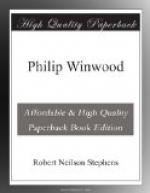CHAPTER III.
Wherein ’tis Shown that Boys Are but Boys.
The Faringfield house, as I have said, was flanked by garden space on either side. It was on the Eastern side of the street, and so faced West, the next house Southward being ours. The wide hall that we entered ran straight back to a door opening from a wooden veranda that looked toward the rear garden. At the right of this hall, as you went in, a broad oak stairway invited you to the sleeping floor above. But before you came to this stairway, you passed a door that gave into the great parlour, which ran the whole length of the hall, and, being used only on occasions of festivity or ceremony, was now closed and dark. At the left of the hall, the first door led to the smaller parlour, as wide but not as long as the great one, and in daily use as the chief living-room of the house. Its windows were those through which the candle-light within had welcomed us from the frosty, snowy air that evening. Behind this parlour, and reached either directly from it, or by a second door at the left side of the hall, was the library, so-called although a single case of eight shelves sufficed to hold all the books it contained. Yet Philip said there was a world in those books. The room was a small and singularly cosy one, and here, when Mr. Faringfield was not occupied at the mahogany desk, we children might play at chess, draughts, cards, and other games. From this room, one went back into the dining-room, another apartment endeared to me by countless pleasant memories. Its two windows looked Southward across the side grounds (for the hall and great parlour came not so far back) to our house and garden. Behind the dining-room, and separating it from the kitchen and pantry, was a passage with a back stairway and with a bench of washing-basins, easily supplied with water from a cistern below, and from the kettle in the adjacent kitchen. To this place we youngsters now hastened, to put ourselves to rights for supper. The house was carpeted throughout. The great parlour was panelled in wood, white and gold. The other chief rooms were wainscoted in oak; and as to their upper walls, some were bright with French paper, while some shone white with smooth plaster; their ceilings and borders were decorated with arabesque woodwork. There were tiled fireplaces, with carved mantels, white, like the rectangular window-frames and panelled doors. Well, well, ’twas but a house like countless others, and why should I so closely describe it?—save that I love the memory of it, and fain would linger upon its commonest details.




